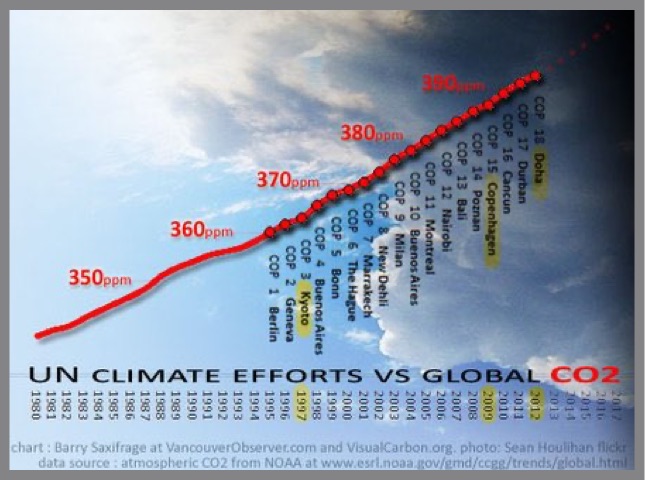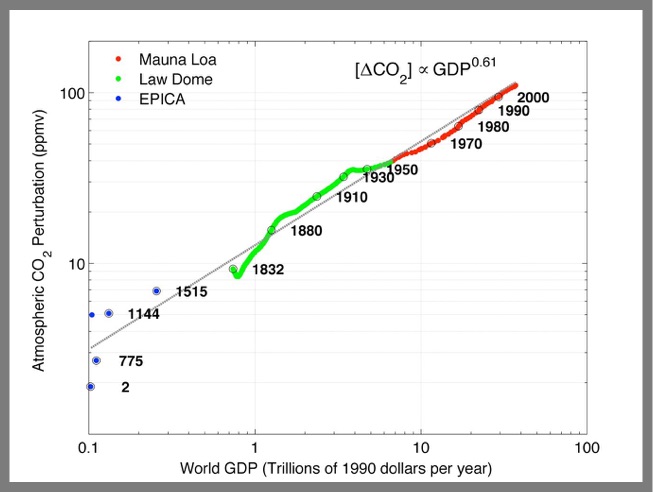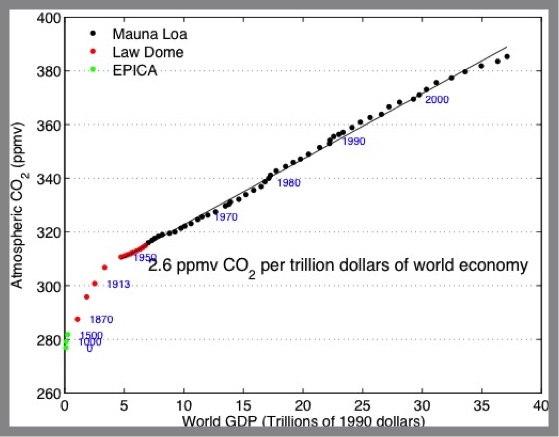Economic growth and climate change
© TIM Garrett 2014
This work is licensed under a Creative Commons Attribution-NonCommercial 4.0 International License.
As the world becomes increasingly aware of the present and future dangers of climate change, and policy makers and scientists make ever more urgent claims of the necessity for moderating emissions of carbon dioxide, international accords are put into place that offer to push civilization’s trajectory along a more favorable course, slowing the worst that is otherwise sure to come.

Yet, with each passing decade, the figure above shows that these accords seem to fall on deaf ears. A naive person might even argue (this is tongue-in-cheek of course) that international accords are the cause of rising CO2 levels: each accord seems to shorten the time it takes to pass each successive increment of 10 ppm.
It’s very depressing to realize that we seem so powerless. Perhaps, even, it begs the question of why we continue to bother sending herds of scientists, policy makers, and social activists to exotic and/or expensive locations, each doing their part to add to atmospheric CO2 concentrations by burning jet fuel, in the vain hopes of stalling the inevitable.
At a deeper level, there is a more important question to consider. We must ask whether a more fundamental, underlying reason exists for why humanity seems unable to moderate behaviors that could very well lead to its own ultimate demise. We can’t really be that crazy, can we?
It’s not as if we are ignorant. There is general appreciation that the driving force behind carbon dioxide emissions is the consumption of fossil fuels as a component of global economic activity. Our fearless leaders often aim to slow emissions by “decoupling” the economy from fossil energy consumption, either by making the economy more energy efficient or by switching to renewable sources of energy. This approach seems very sensible and reasonable, at least at first glance. It offers policy makers the wonderful possibility of being able to have the cake and eat it too; to stimulate the economy while saving the planet. What’s not to like?

But as always, it helps to look at the data, and to keep in mind that very often “it ain’t necessarily so”. Consider the above plot, which shows the relationship between the atmospheric concentration of CO2 above a baseline of 275 ppm and the world’s total GDP, adjusted for inflation to 1990 dollars (see Garrett, 2012 for details). Data is taken from a mixture of ice cores for older dates and gas samples for newer dates.
What is immediately evident is that, on a log-log plot, there has been an extraordinarily tight relationship between GDP and CO2 concentrations for at least 2000 years. As long as we look at global scales, each ten-fold increase in GDP has always corresponded with an approximate four-fold increase in excess CO2.

If you prefer a linear plot, it works out to 2.6 ppm extra per trillion dollars of world economy since 1950. In fact, the relationship is so tight, that one could imagine (just for fun) switching the axes and concluding that one could measure the size of the global economy just using simple a CO2 sensor stationed in Hawaii.
The point here is that there is nothing in the data to suggest that there is any potential for reducing CO2 concentrations in the atmosphere, at least not without a total collapse of the economy. One does have to be careful, because finding a correlation between two things can often be a misleading. CO2 concentrations accumulate over time due to past actions whereas GDP represents our current actions. The two are inevitably linked, but it would not be correct to attribute direct causality. Nonetheless, at the very least, we should be asking what would have to happen in the future that is fundamentally different from the past if decoupling is to happen.
To get an appreciation of the more detailed dynamics of the problem, how the past is linked to the present, along with forecasts for where civilization might be heading subject to fundamental physical constraints, the following two papers might be of interest:
No way out? The double-bind in seeking global prosperity alongside mitigated climate change, Earth System Dynamics
Long run evolution of the global economy: 2. Hindcasts of Innovation and Growth, Earth System Dynamics
Reducing CO2 emissions may be a bit like asking an adult to once again become a child. Over millennia, we have collectively built an enormous global infrastructure designed to consume energy. Without destroying this infrastructure, energy will continue to be consumed. Without energy, the circulations defining the global economy stop. And because so much of this infrastructure is tied to fossil fuel consumption, our economy is wedded to CO2 emissions. We as humans breath oxygen to access the energy that lies in carbon compounds within food, and exhale CO2 as a result. Not exhaling leads to death. Other than the detail that our primary source of energy is the carbon compounds within fossil fuels, is the exhalation of CO2 by civilization any different?
Economics About Physics of the economy What is wealth?
Energy, Innovation and growth Economic inertia Economic Forecasting Jevons' Paradox
Physics vs Mainsteam Economics Is Macroeconomics a Science? The economic heat engine
Economics and Climate GDP is not Wealth Are renewables the answer?
Is population growth a problem? Will growth transition to collapse?
What is your carbon footprint? Media Publications Presentations FAQ Criticisms
